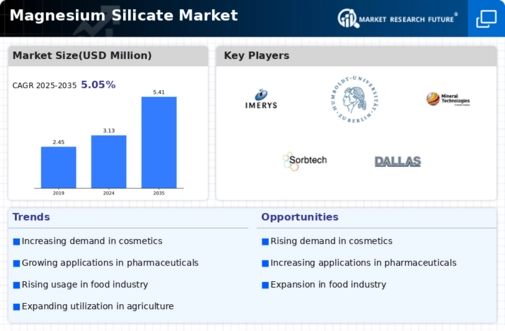COSMETICS INDUSTRY GROWTH IN DIFFERENT REGIONS
The cosmetics industry is growing rapidly worldwide, and this growth is being driven by factors such as increasing urbanization, rising disposable incomes, and growing awareness of personal care and grooming. The cosmetics industry is expected to grow at a CAGR of 4.2% from 2023 to 2030, to reach USD 363.80 billion by 2030.
The following are some key trends in the cosmetics industry that are driving demand for magnesium silicate:
Increasing demand for natural and organic cosmetics: Consumers are increasingly demanding cosmetics that are made with natural and organic ingredients. Magnesium silicate is a natural mineral, so it is a good option for consumers who are looking for natural and organic cosmetics.
Growing popularity of Asian cosmetics: Asian cosmetics are becoming increasingly popular around the world. Asian cosmetics are known for their high quality and innovative products.
Magnesium silicate is a popular ingredient in many Asian cosmetics products.
Rising demand for men's cosmetics: The men's cosmetics market is growing rapidly. Men are becoming more interested in taking care of their skin and appearance. Magnesium silicate is used in a variety of men's cosmetics products, such as shaving creams and aftershaves.
The cosmetics industry is growing in all regions of the world, but the fastest growth is being seen in emerging markets such as Asia Pacific and Latin America. This growth is being attributed to the factors mentioned above, such as increasing urbanization and rising disposable incomes. As a result of the growth of the cosmetics industry in different regions, demand for magnesium silicate is also increasing. Magnesium silicate producers are expanding their operations and developing new products to meet the growing demand.
Overall, the cosmetics industry growth in different regions is driving demand of magnesium silicate and will impact the market positively in long term.
USAGE OF MAGNESIUM SILICATE IN FOOD AND BEVERAGES
The usage of magnesium silicate in food and beverages as an emulsifier, anticaking agent, and baking agent is driving its growth, with increasing frozen, fast foods, as well as ambient food growth by region.
Frozen foods
Magnesium silicate is used in frozen foods to prevent them from clumping and to improve their texture. It is a popular ingredient in ice cream, frozen yogurt, and frozen pizzas.
Fast foods
Magnesium silicate is used in fast foods to improve their flowability and to prevent them from sticking to packaging. It is a popular ingredient in breading, batter, and powdered sauces.
Ambient foods
Magnesium silicate is used in ambient foods to prevent them from caking and to improve their flowability. It is a popular ingredient in baked goods, cereals, and powdered drinks.
The increasing demand for frozen, fast, and ambient foods is driving the growth of the magnesium silicate market in the food and beverage industry. This growth is being attributed to factors such as increasing urbanization, rising disposable incomes, and changing lifestyles.
Asia Pacific region is expected to witness the fastest growth in all three markets during the forecast period. This growth is being attributed to the factors mentioned above, such as increasing urbanization and rising disposable incomes. The growing demand for frozen, fast, and ambient foods is driving the growth of the magnesium silicate market in the food and beverage industry. Magnesium silicate producers are expanding their operations and developing new products to meet the growing demand.
Overall, the usage of magnesium silicate in food and beverages as an emulsifier, anticaking agent, and baking agent is driving its growth, with increasing frozen, fast foods, as well as ambient food growth by region.
INCREASING DEMAND FOR NATURAL AND ORGANIC PRODUCTS
Magnesium silicate is a natural mineral that is used in a wide range of products, including cosmetics, food and beverages, and construction materials. It is a popular ingredient in natural and organic products because it is safe, non-toxic, and biodegradable.
The demand for natural and organic products is growing rapidly. This is due to a number of factors, including increasing awareness of the health and environmental benefits of these products. Magnesium silicate is a good option for consumers who are looking for natural and organic products because it is a safe, effective, and versatile ingredient.
Examples of how increasing demand for natural and organic products is creating opportunities for magnesium silicate growth
Cosmetics industry: Magnesium silicate is a popular ingredient in natural and organic cosmetics products. It is used in a variety of products, including makeup, skincare, and haircare products. Magnesium silicate is valued for its properties such as oil absorption, slip, and opacity.
Food and beverage industry: Magnesium silicate is used in a variety of natural and organic food and beverage products. It is used as an anti-caking agent, emulsifier, and baking agent. Magnesium silicate is also used in some plant-based food products to improve their texture and stability.
Construction industry: Magnesium silicate is used in a variety of natural and organic construction materials. It is used as a filler in concrete and mortar, and it is also used in some insulation materials. Magnesium silicate is valued for its properties such as fire resistance and sound absorption.
Overall, increasing demand for natural and organic products is creating significant opportunities for magnesium silicate growth. Magnesium silicate producers can capitalize on these opportunities by developing new products and solutions that meet the needs of their customers. They also need to expand their reach into new markets and industries.
The Global Magnesium Silicate Market appears to be experiencing a notable shift towards sustainable applications, driven by increasing demand in industries such as cosmetics and pharmaceuticals, which suggests a growing recognition of its multifunctional properties.
U.S. Geological Survey








Leave a Comment